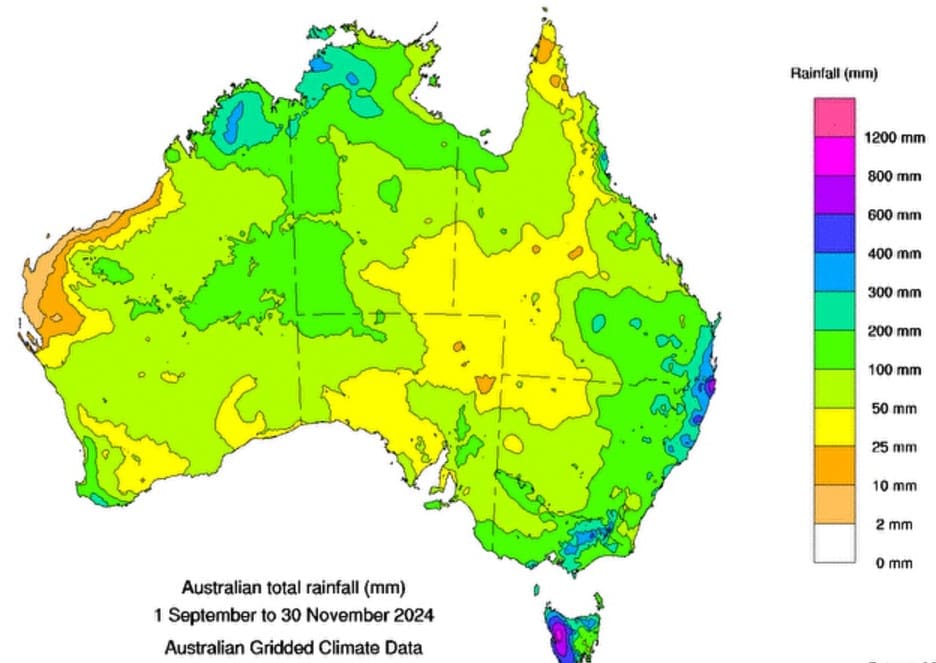
THE unusually wet late-spring/early summer season has set up the early stages of the 2025 cattle slaughter season for some significant structural changes.
As can be seen on this BOM map above, recording rainfall for the past three months to the end of November, the eastern half of NSW, Victoria and Queensland has now received solid rainfall of 100-200mm heading into the hottest part of the year.
On current performance, Queensland is facing a particularly long summer grass-growing season, and the impact will be clearly seen in cattle turnoff patterns in the early stages of 2025.
November can often be a tough month for the northern cattle industry, but recent rain has now filled in a lot of gaps, stretching from Northwest Queensland and into the Barkly, all the way to the NSW border. Indeed, Some locations in Queensland received record high November rainfall registrations.
Similarly, large parts of the Top End, Kimberley, VRD and Central Australia have received falls of 100-200mm since September (lime green areas on the map). For some, it’s shaping as the fourth consecutive better-than-average summer growing season – unprecedented in Australia’s climate and weather history.
Further south, parts of Victoria and southern NSW have also had unusually high rainfall, for this time of year.
As discussed earlier, the recent precipitation has had a clear impact on producer sentiment, with recent evidence of some Queensland and northern NSW cattle operators holding cattle back for kills earlier next year, at heavier weights.
With plenty of cattle gaining condition since October, Queensland processors are now anticipating an early surge to slaughter numbers, especially cows, in the opening stages of the new slaughter season.
“Ar this stage we’d expect the first big wave of turnoff to happen perhaps a month earlier than normal,” one large multi-site operator told Beef Central.
“Barring serious rain disruptions, we’d anticipate bigger numbers of well-finished cows and steers from February, rather than March next year. Rain access disruptions might be the only disruptor to that. Temperatures have been reasonably moderate so far this summer, and the feed that’s struck so far after rain, has not been burnt off,” he said.
“And another point is, that cattle were not in bad shape, even before the rain started, meaning they were further ahead than they otherwise might be. And on top of that, some operators have clearly held cattle back for next year – evidently cash flow isn’t a problem.”
Carcase weights are also likely to be solid again in the opening stages of 2025.
“But having said that, cow weights through 2024 have been very strong,” one large southern Qld processor said. His plant has averaged 290kg carcase weight on good cows across this entire year, perhaps 15kg above the long-term average.
“There’s no reason at this stage to suspect that February-April kills next year will not carry plenty of weight – long growing seasons inevitably deliver that,” he said.
“It’s even reflected in grainfed cattle weights – finished steers are heavier than normal, because they went onto feed at heavier weights. Any of our shortfeds are averaging 360kg or better, and midfeds this year 400+kg.”
Rain impact
Rain over the past week has again slowed cattle delivery for some Queensland and NSW processors, although cancellations have been only modest. One site lost 150 head this week, but was able to substitute others in, in their place.
Most Queensland processors are still buying a few over-the-hooks slaughter cattle for final weeks commencing 9 and 16 December, but only in limited numbers. Some operators are accepting space bookings for early 2025 kills, but unpriced at this stage.
Beef Central will publish a list of seasonal closure and 2025 re-opening dates for Eastern states processors in coming days.
Grids steady
While northern export processors are not over-endowed with slaughter stock, supply is adequate to see the year out, Beef Central understands.
All grids remain unchanged this week, and now look unlikely to move much before the lights are turned off for 2024.
Some large Queensland multi-site export processors lifted rates 20c/kg last week, but that move was largely in response to competitors who made similar adjustments a week earlier.
For delivery in the state’s southern region in the next couple of weeks, expect to see grids offering 560c/kg on heavy cows and 620-630c on four tooth heavy grass ox, with implant. Processors in Central Queensland are typically 10c behind that.
In southern states, there was evidence of some over-the-hooks rates easing further lkast week, but most offers are steady this week. Operators in eastern parts of South Australia are offering 540c/kg on good cows this morning, and 610c on four-tooth grass ox.
Southern NSW rates are mostly unchanged this week, with representative samples showing 510c/kg on heavy cows and 590c/kg on grass ox, reflecting the recent lift in supply.
Last week’s national slaughter continued the recent rapid pace of production, hitting 143,428 head.
There has been a pronounced kick in weekly slaughter number since mid-October, with seven of the past eight weeks above 143,000 head – easily the busiest two-month period of the year.
